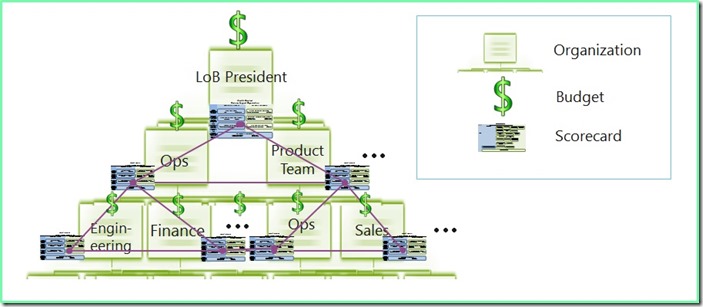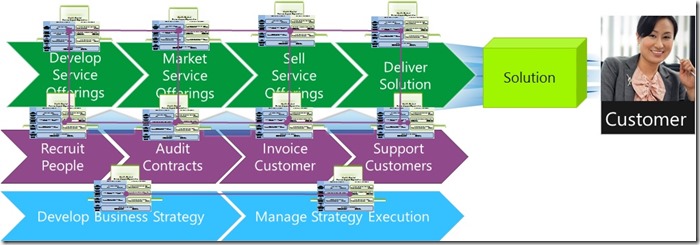The Planning Paradox
One of my uncle’s favorite jokes goes like this:
Greg: “Hey Gabriel, say to me ‘what’s the most important thing about humor?’”
Gabriel: “Okay Greg, what’s the mo-“
Greg: “Timing.”
[At this point, you’re supposed to laugh]
“Timing” is the most important thing to business strategy planning
As it turns out, timing is also the most important thing to support business performance management in terms of managing scorecards and synchronizing them with their project portfolios across a company.
Organizational Hierarchy Strategy Alignment. Organizational Hierarchy Strategy Alignment is the linkage between organization’s scorecards and budgets based on an organization’s hierarchy. The head of an organization’s scorecard and budget links to its children’s organizational scorecards and budgets forming a pyramid-like structure of strategy alignment like the illustration below.
Value Stream Strategy Alignment. From a business strategy perspective, there are two types of organizations in a company; Business Organizations and Support Organizations. A Business Organization is an organization that is responsible for a product with scorecard KPIs related to market share, revenue and customer satisfaction.. All other organizations in a company are Support Organizations with scorecard KPIs related to cost, productivity, quality and risk. Business Strategy is set by the Business Organizations and Support Organizations mobilize to enable them, ideally in a sequential flow based on the Product’s value stream (aka core value stream, value chain and operating model). That is, organizations that deliver a product define their scorecards to express what success look like normally using KPIs like “units delivered”, “revenue received”, “customer satisfaction”. Then, working back up the value stream, Support Organizations determine how to sell the product to hit the desired success targets set by the deliver organization. Then, Support Organizations that market the product define KPIs on their scorecards to express what success looks like to hit the sale’s organization’s KPI Targets. Of course, not all processes are directly involved in the core value stream. Support Organizations that support customers, invoice/bill customers, hire people, manage partners, etc all have an enabling/support role and should work back from the core value stream process to determine what their success looks like based on the organization’s processes that they support. Here’s an illustration of a business strategy cascaded via value streams.
The Planning Paradox
More common than you think, organization’s use a planning schedule to arrive at organizational scorecards and budgets that starts at the top of an organizational hierarchy and flows down from there. The problem is that organizations are rarely organized by value streams. In situations where the Business Organization is a sibling organization to Support Organizations, they both have to produce their scorecards and budgets at the same time forcing Support Organizations to scramble to discover the Business Organization’s strategy to then set their own scorecard for success and the budget necessary to achieve it. Even further, there are times when Business Organization functions report to Support Organizations forcing the Support Organization scorecards and budgets to be set before the Business Organization can declare what they need to be successful. In my experience, this situation causes several intense activities in brief stints that ultimately result in a undocumented alignment of business strategy leaving open the possibility of gaps, overlaps and conflicts in plans to execute the business’ strategy.
To add to the problem, it’s also worth mentioning these challenges posed when business strategy is poorly aligned:
- Lack of ability to perform impact analysis to make upstream groups aware of dependent projects slipping/failing to set expectations
- 60% of Organizations don’t map Organizational Scorecard KPIs to funded projects *
- 66% of HR and IT organizations have no link to the business strategy *
- 70% of middle manager’s and 90% front-line employee’s compensation not linked to the business’ strategy *
- 95% of employees in most organizations do not understand their business’ strategy *
* Harvard Business School, 2006, “The Office of Strategy Management”, https://hbswk.hbs.edu/item/5269.html

